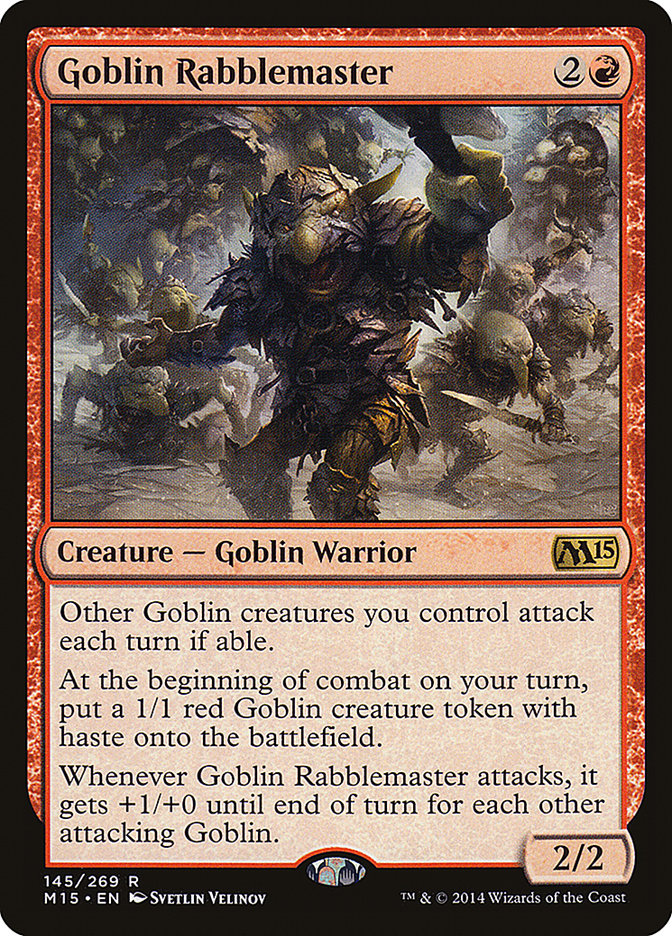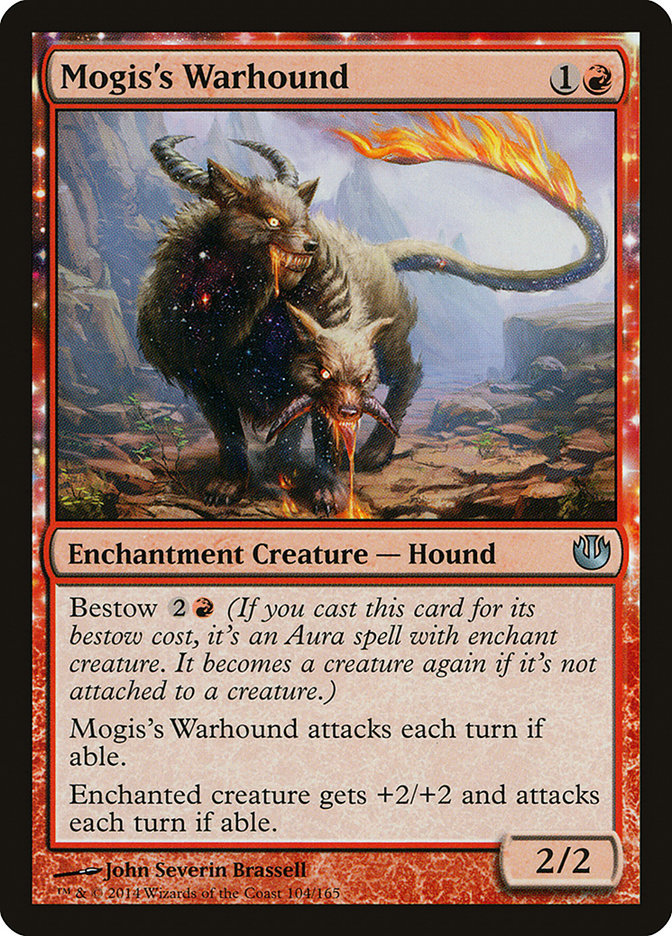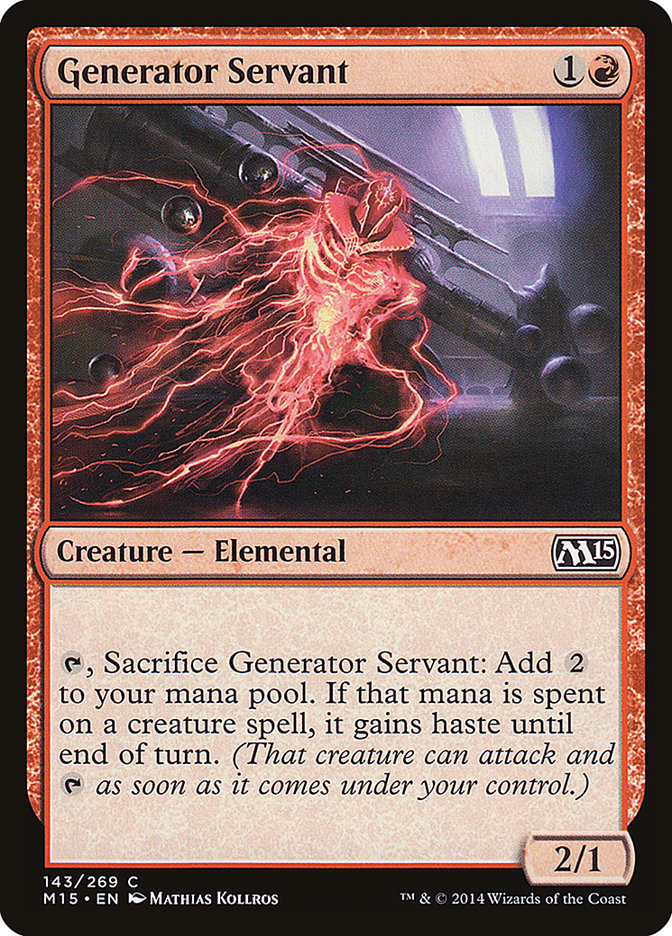Rabble Red.
The name carries a certain gravitas. When you play against it, you know what’s coming. Cheap creatures, burn spells, and tricks to throw you off balance.
The deck is absolutely absurd when no one is gunning for it, and still incredibly resilient when they are. All because of this guy:
Regardless of how you think the format is going to shape up with Khans of Tarkir, Goblin Rabblemaster is going to be around for at least another year, and
it will put you in your place. Your cute three-color deck will be far too slow to keep pace with the Rabblemaster and his crowd of crashing goblins.
But we lost a lot of important tools for Rabble Red, not unlike the rest of the decks in Standard. Everyone took a hit. No more Mono-Blue Devotion. No more
Supreme Verdict. And we no longer have Rakdos Cackler, Burning-Tree Emissary, or Rubblebelt Maaka. In fact, we don’t even have Mutavault for the games that
go long. So what do we do?
We mix a little bit of the old with the new, and try to find a balance.
Boss Sligh, aka the red deck centered around Akroan Crusader, has similar elements to the current version of Rabble Red, though they function quite
differently. Dragon Mantle and Titan’s Strength don’t really work all that well with Goblin Rabblemaster, but work perfectly with a lot of cheap one-drop
creatures. The trick here is figuring out that Goblin Rabblemaster is just an outrageous threat on its own and doesn’t really need a lot of help. The rest
of your deck can do whatever you want, and it won’t really matter all that much when you cast Rabblemaster and have it live for a turn.
I’ve fallen in love with the Rabble, and I’ve been playing it non-stop over the last month in many forms. I’ll be sad to see it change so much with the
rotation, but all is not lost. Even though Khans of Tarkir is a set based around wedges and will likely shun mono-colored cards, I’ve already found a few
goodies to try out, as well as some oldies that need a revival.
One card that was phenomenal in our early testing for the Theros Block Pro Tour was Mogis’s Warhound. It allowed red decks to get over the hump of Sylvan
Caryatid and Courser of Kruphix with ease. That is until we found out how good Silence the Believers was, and then that strategy sort of fell apart.
Honestly, I don’t think Silence the Believers is going to be as heavily played in the new Standard format, as a four-mana removal spell is quite expensive,
but it does pair well with Hero’s Downfall. I think that Silence the Believers could be good should everyone try to one-up each other with gigantic,
three-color creatures. Though hilariously enough, many of them have hexproof.
With that said, I’m still high on Mogis’s Warhound in the new versions of Rabble Red. It’s fine as a two-drop creature but pushes your heavy mana draws
over the top.
Aside from Mogis’s Warhound getting some love now that our good friends Burning-Tree Emissary, Ash Zealot, and Firefist Striker are gone, we have another
solid two-drop from Khans of Tarkir that gets around Sylvan Caryatid, even when you don’t get to use the raid ability.
If you want to have a lot of one-drop creatures in your deck, then War-Name Aspirant is quite good. I think that should be pretty easy considering we still
have Firedrinker Satyr, as well as Akroan Crusader and a few other options. I’m not sure what the other one-drop creatures should be just yet, but Foundry
Street Denizen isn’t so bad, other than the obvious non-bo with raid. Frenzied Goblin isn’t out of the running yet though.
But War-Name Aspirant isn’t just a 3/2 for 1R. It actively makes blocking difficult for the opponent, whether that means chump blocking or double blocking
with cards like Elvish Mystic, Voyaging Satyr, or other mana producers. In any sort of mirror match, your opponent will likely have various goblins and
other assorted 1/1 creatures that can’t trade with War-Name Aspirant, regardless of whether or not you triggered raid.
What’s strange to me is that War-Name Aspirant feels similar to Gore-House Chainwalker, and that guy was never an all-star. But this is a much different
world we live in, as decks will be significantly slower thanks to the new clan wedges, and Sylvan Caryatid is at an all-time high when it comes to
playability. I’ve already played a few games with War-Name Aspirant, and it overperformed, but I’m not going to look too much into such a small sample
size. Regardless, when something feels strong, I tend to give it more attention.
Other than the one new addition, everything else is just a bunch of stuff we’ve had access to all along but that was overshadowed by some of the more
powerful cards in Return to Ravnica. Without Supreme Verdict in the format, we have an extra turn before End Hostilities punishes us for over-extending.
There will be far fewer black-based decks ruining our fun with Drown in Sorrow, and two midrange red decks will feature mana accelerators, pushing them
away from Anger of the Gods.
So I think that leaves us in a pretty sweet spot.
Creatures (24)
- 4 Foundry Street Denizen
- 4 Akroan Crusader
- 4 Firedrinker Satyr
- 4 Mogis's Warhound
- 4 Goblin Rabblemaster
- 4 War-Name Aspirant
Lands (20)
- 20 Mountain
Spells (16)

This deck is a sleek hybrid of two Tom Ross creations. His Boss Sligh deck from the Pre-M15 Invitational in Columbus was awesome, though we lost access to
many of the cards that made that deck great. When paired with the Rabble Red deck we know and love from the last two months, we’re able to implement both
gameplans simultaneously without much effort.
Cards like Titan’s Strength and Dragon Mantle are ways to cheat on our land count, as both drawing cards and scry allow us to get away with playing fewer
lands. On top of that, Dragon Mantle also gives us the ability to utilize excess lands drawn, threatening to let our smaller creatures trade up or deal
significantly more damage. Titan’s Strength is also fantastic in combat scenarios involving an opposing Polukranos, Courser of Kruphix, or some other
baddie with a lot of toughness. It will generally result in them gaining a two-for-one on you, but tempo matters much more than card advantage in these
cases.
I also love the interaction between Akroan Crusader and Stoke the Flames. Creating a lot of soldiers while gaining small points of value is fantastic, and
it gets even better when you create enough creatures to cast Stoke the Flames with ease. Stoke the Flames is one of the best burn spells ever printed, and
I’ve been incredibly pleased with how versatile it is. There are spots where good ol’ Lightning Blast is just fine, but there are other times where Stoke
the Flames is virtually free. Having multiple ways to generate extra creatures to supercharge it is unreal.
Creating tokens on two different fronts, whether it is Goblin Rabblemaster or Akroan Crusader, will also make Hall of Triumph much stronger. Most of the
time, Hall of Triumph will just be a way to bolster your squad, helping you bust through board stalls. It will make combat fairly difficult for them while
simultaneously dealing a few extra points of damage. It also acts as a way to apply virtual pressure without putting another creature into play, which is
fantastic against decks featuring sweeper effects. If Drown in Sorrow becomes a big deal, then it might actually be correct to play a second copy of Hall
of Triumph in the sideboard.
The Coordinated Assault in the list is a nod to losing Legion Loyalist. Legion Loyalist giving Goblin Rabblemaster trample and first strike was huge in a
number of situations, but we don’t have access to that anymore. Coordinated Assault gives that threat back to us, and although it is significantly worse, I
think it is still good enough. The fact that you can target multiple creatures with it also makes Akroan Crusader a little bit better and can give you a
solid trick against things like Courser of Kruphix when paired with War-Name Aspirant. Crowd’s Favor might actually be better, as it can be virtually free
with convoke, but being able to target multiple creatures in combat is huge, on top of just dealing an extra point of damage if you’re trying to finish
them off.
It is pretty difficult to build a coherent sideboard just yet, as we don’t have access to the entire spoiler for Khans of Tarkir, but I wanted to try out
Jeering Instigator over something like Harness by Force, simply because of how versatile it can be. If you don’t have a two-drop creature on the play to
hit your curve, it serves just fine as a beater. And if your opponent is playing Polukranos, things get out of control if you get to untap with it.
Jeering Instigator is pretty sweet on the play but could have problems if you’re on the draw. Assuming they’re able to play a Polukranos on turn 3 via
Elvish Mystic or Sylvan Caryatid, you won’t have time to take it before they monstrous and fight your morph.
Searing Blood and Magma Spray are there for the inevitable aggressive decks in the format. Heroic is a mechanic that wasn’t explored much in the previous
Standard format, but was quite powerful in Theros Block. Having cheap ways to kill their early threats is important. On top of that, there is still the
potential threat of other aggressive decks featuring cheap curves, all trying to prey on the slower three-color decks. Soldier of the Pantheon, Tormented
Hero, and the like will all fall victim to Searing Blood and Magma Spray.
If these kind of decks crop up in large numbers, there are a few other goodies we could try out. Forge Devil doesn’t actually seem all that bad, to be
honest. There are a lot of cheap creatures that it can obliterate, and we’re all about having creatures with sweet abilities when we’re playing Foundry
Street Denizen and Hall of Triumph.
Flame On
If you’re looking to get a bit bigger with your red deck, you have some great options at your disposal. We’ve lost a lot of the heavy-red devotion cards
from Return to Ravnica, but the replacements aren’t all that bad. In fact, we even have a way to play Sarkhan, the Dragonspeaker on Turn 3!
This guy hasn’t gotten much love since its debut in M15, but I wouldn’t underestimate it. While it does feel similar to Satyr Hedonist, which has seen
virtually no play in Standard thus far, it does keep you in a single color as opposed to two. You also have the added benefit of giving your creatures
haste, which could be particularly spicy with a certain rabbling goblin.
Generator Servant isn’t exactly exciting, but the cards surrounding it could very well define Standard in the coming months. Devotion decks aren’t getting
nearly as much press as they should be, and Nykthos, Shrine to Nyx seems to be overshadowed by all the hype surrounding the enemy wedges. Of course, that
is only natural, considering the new set comes out in just a few weeks, but I’m a practical man. I see new cards that cost five, six, or seven mana, and I
just wonder how well they’ll match up against the already-existing powerful cards from Theros.
While it will be much harder to make Nykthos, Shrine to Nyx good in the new Standard, what with so many devotion enablers leaving the format, I still think
Nykthos could prove to be one of the defining cards at Pro Tour Khans of Tarkir. It will be less explosive without Burning-Tree Emissary in the mix but
still a potent weapon for decks that aren’t as reliant on it to fuel the fire. This deck is not a great example of how to abuse it, but rather a deck that
can take advantage of it in the mid or late game.
If you’re looking for a bigger red deck, then look no further.
Creatures (20)
- 2 Purphoros, God of the Forge
- 4 Firedrinker Satyr
- 4 Eidolon of the Great Revel
- 4 Generator Servant
- 4 Goblin Rabblemaster
- 2 Ashcloud Phoenix
Planeswalkers (6)
Lands (25)
Spells (9)

This deck feels unique in that it can play the aggro or control role pretty easily. Cards like Firedrinker Satyr and Eidolon of the Great Revel are
fantastic at putting pressure on slower decks, while Goblin Rabblemaster and Sarkhan, the Dragonspeaker act as threats that hit very hard if left
unchecked. But the deck, like Sarkhan himself, can play the control role if necessary.
Stoke the Flames and Chained to the Rocks provide you with some powerful removal, yet both can act as tempo plays to help your cheaper creatures deal
damage. Ashcloud Phoenix also feels superb on both offense and defense and they remind me a lot of Voice of Resurgence. Against decks that are trying to
attack you, it’s alright to block! You get a 2/2 for the exchange with the threat of flipping it again in just a few turns.
The synergy between Purphoros, God of the Forge and Goblin Rabblemaster is just ridiculous. That two-card combination is devastating against anyone trying
to durdle around with Courser of Kruphix without access to a hefty amount of removal. Being able to pump all the tokens with Purphoros is just icing on the
cake.
What I dislike about this version of Red Devotion is that you don’t have nearly as many creatures that help power Nykthos to its full potential, but I
think that was intentional with design. No one wants to see Nykthos dominate the format completely. You do have the potential to abuse it if the game goes
late, allowing you to play multiple spells or activate Purphoros a million times. It won’t be as explosive as it once was, which is why we’ve cut down to
two copies, but it will still be good.
Fluidly switching between the aggressor and the defender with this deck feels easy. After sideboard, you get access to a plethora of amazing options such
as Nyx-Fleece Ram and Magma Spray, both of which help fight Rabble Red and its ilk. Banishing Light also plays the role of fighting opposing planeswalkers
alongside Phyrexian Revoker. Elspeth, Sun’s Champion will be a pretty big deal in the new Standard format, and I want ways to keep it in check. Phyrexian
Revoker, unlike Pithing Needle, is a vulnerable answer though and might not be good enough, but I think it deserves a shot at least.
There are a few other options that I would like to try out, namely Fanatic of Mogis, although I’m not sure if it is actually good enough without the
ridiculous amount of cheap devotion enablers that we lost with the rotation. Plus, Ashcloud Phoenix looks sweet, and I’d love to test it out a bit. There
are a few other solid one and two-drop creatures that could make the cut over Eidolon of the Great Revel, but I feel like the damage output of Eidolon is
too great to ignore. It has virtual haste if your opponent kills it and shouldn’t deal you too much damage. Regardless, your life total will matter much
less than your opponent’s most of the time.
If you guys have any ideas for either of these decks, I’d love to hear them. I think that one and two color decks will be pretty sweet once Khans of Tarkir
comes out, simply because people are trying to be too cute! Yes, the cards are powerful. Yes, the manafixing exists to make the spells castable. But that
doesn’t mean you will be able to cast them before you die a fiery death at the hands of Goblin Rabblemaster!
I’ll leave the brewing of three-color decks up to people who enjoy playing solitaire.





